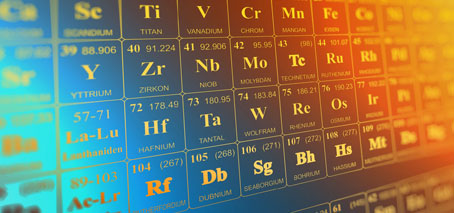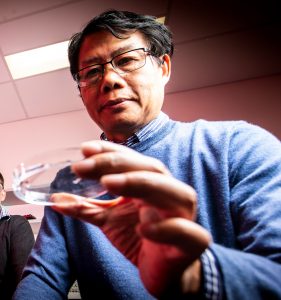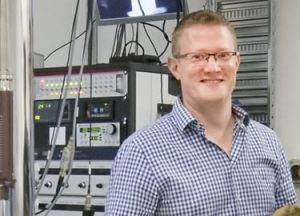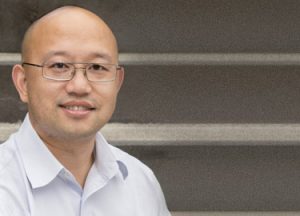- Harnessing massive Dirac fermions in dual-magnetic-ion-doped Bi2Se3 topological insulator showing extremely strong quantum oscillations in the bulk.
- Double doping induces a gap for the topological surface state.
A University of Wollongong-led team across three FLEET nodes has combined two traditional semiconductor doping methods to achieve new efficiencies in the topological insulator bismuth-selenide (Bi2Se3),
Two doping elements were used: samarium (Sm) and iron (Fe).
The resulting bismuth-selenide crystals show clear ferromagnetic ordering, a large bulk band gap, high electronic mobility, and the opening of a gap of surface state making this system a good candidate to achieve QAHE at the higher temperatures necessary for viable, sustainable future low-energy electronics.
“The combination of electronic and magnetic properties in topological systems is the keystone of novel topological devices, and one of the core projects in FLEET,” says project- leader Prof Xiaolin Wang (UOW). “We have proposed and successfully realized a new way to magnetize a novel electronic material—a topological insulator—by adding two different magnetic ions.”
Each one of various different magnetic elements used in magnetizing a topological insulator possesses its own advantage and disadvantage. However, while in previously studies, only one element was employed, the UOW-Monash-RMIT team found that the combination of two elements also combined advantages of each.
“The dual doping strategy is thus proved viable for the growth of extremely high quality topological insulators with both magnetism and excellent electron mobility which are vital for low-energy electronic devices”, says the study’s lead author, Dr Weiyao Zhao.
One dose is not enough: the limitations of transition-metal doping
Topological insulators (TIs) are emergent materials with a unique band structure allowing the study of quantum effect in solids, as well being promising components of future, high-performance quantum devices.
There are the two key elements in the quantum anomalous Hall effect (QAHE) that ‘drives’ desirable properties in topological insulators and all related electronic technology:
These are (a) ferromagnetism, and (b) the topological electronic insulating property.
The collaborative FLEET study, combining expertise from UOW, Monash and RMIT pioneered a ‘dual element’ doping strategy to introduce magnetism in a topological insulator, thus improving both key elements at once.
Combining the advantages of two different doping elements, iron and samarium, results in large crystal growth, with a large surface band-gap, and huge quantum transport effect.
The previous approach to realize quantum anomalous Hall effect (QAHE) in a topological insulator employed doping with a single transition-metal, such as iron (Fe), to create ferromagnetism.
The transition-metal doping technique has been successful in creating the desired magnetic ordering. However, there is a significant disadvantage of this method: The in-lattice transition metal jeopardizes the desired high-mobility of the topological insulator, which in the case of low-energy electronics, defeats the purpose of using topological insulators at all!
Thus, QAHE has been realized via transition metal doping strategy only at extremely low temperatures, which would require energy-intensive cooling. Again, this reduces the viability of such materials for future low-energy electronics.
To increase the operating temperature of QAHE, stronger magnetic interaction and higher mobility are desired.
Double doping achieves the two key, desired elements of QAHE

In double-doped (Sm/Fe) bismuth-selenide, both Sm and Fe carry large magnetic moments (shown in red), with fainter induced moments appearing on selenium atoms (green) coordinating the Fe. **
After considering the successful elements of doping using transition metals such as iron (Fe), the research team decided to further introduce a stronger magnet, the rare earth element samarium (Sm), into the well-known topological insulator bismuth-selenide (Bi2Se3).
The doping elements iron and samarium create the necessary ferromagnetic ordering in the crystals, which can open a massive gap at the Dirac cone of surface state. This is an essential element of achieving QAHE.
Further, the team proved that, in the dual magnetic doped crystals, the electron mobility remains very high, by confirming the presence of an ultra-strong quantum oscillation effect, and step-like Hall effect.
The mobility of topological insulators such as bismuth-selenide is several times faster than in classical semiconductors, such as silicon.
Such a crystal idealizes the two important elements of QAHE.
The resulting crystals show clear ferromagnetic ordering, a large (∼44 meV) band gap, and high mobility (∼7400 cm2/Vs at 3 K) and Hall steps in transverse resistivity, confirming the presence of QAHE.
“The samarium and iron dual-doped Bi2Se3 crystal will be an ideal system to achieve QAHE at higher temperatures,” says corresponding author Dr Mark Edmonds (Monash). ”This may be a new way to cover the shortage of magnetic elements.”
“The dual doping strategy is also proved positive to utilize topological insulators in low-energy electronic devices.”
“DFT calculation indicates that the dual doping results in a half-metallicity, fully spin polarized electrons in the system,” adds corresponding author Prof Xiaolin Wang. “This paves another avenue to potential applications in spintronics, as well as contributing to the diversity of the topological matter family.”
The Study
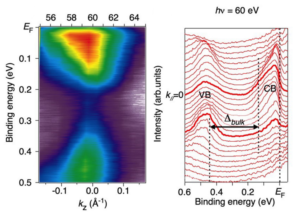
Angle-resolved photoelectron spectroscopy (ARPES) at ALS Berkeley shows photon-energy dependence (left) and energy distribution curves (right) **
Massive Dirac fermions and strong Shubnikov–de Haas oscillations in single crystals of the topological insulator Bi2Se3 doped with Sm and Fe was published in Physical Review B in Aug. 2021. (DOI: 10.1103/PhysRevB.104.085153).
This collaborative UOW-Monash-RMIT project was led by Prof Xiaolin Wang (Wollongong), Dr Mark Edmonds (Monash), and A/Prof Lan Wang (RMIT). Prof Wang is the theme leader of FLEET’s Enabling technology A (novel and 2D materials), and the Director of the Institute for Superconducting and Electronic Materials (ISEM) at the University of Wollongong.
As well as funding by the Australian Research Council (Centres of Excellence, Future Fellowship and Discovery programs), the research benefitted from the resources of Australia’s National Computational Infrastructure (NCI). ARPES measurements were performed at the Advanced Light Source (ALS) at Lawrence Berkeley National Laboratory, USA, supported by the Australian Synchrotron’s International Synchrotron Access Program.
** images from Physical Review B 10.1103/PhysRevB.104.085153
More information
- Contact Prof Xiaolin Wang (University of Wollongong) xiaolin@uow.edu.au
- Contact Dr Mark Edmonds (Monash University) mark.edmonds@monash.edu
- Contact A/Prof. Lan Wang (RMIT) lan.wang@rmit.edu.au
- Read more news about FLEET’s Enabling Technology A

